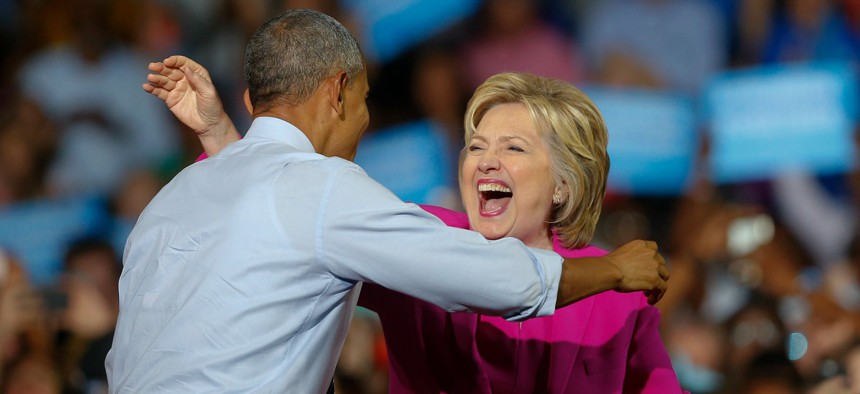
Obama campaigns with Clinton in North Carolina on Tuesday. John Bazemore/AP
Obama Makes His Debut on the Campaign Trail
The president joined Hillary Clinton in Charlotte, North Carolina, Tuesday, singing her praises as a friend and former rival.
In his 2016 campaign-trail debut, President Obama characterized his relationship with Hillary Clinton as one not only of colleagues, but of kindred spirits. Repeatedly drawing connections between her political goals and his—like expanding health care and securing a nuclear deal with Iran—Obama’s implicit message to voters came through: to admire me is to admire Clinton, and to trust me is to trust her.
“We may have gone toe-to-toe, from coast to coast, but we stood shoulder-to-shoulder for the ideals that we share,” Obama said, referring to their work together after the 2008 Democratic primary. Later describing her tenure as secretary of state, Obama added: “My faith in Hillary Clinton has always been rewarded.”
Obama’s appearance with Clinton Tuesday in Charlotte, North Carolina, comes roughly one month after Obama formally endorsed Clinton, in what was “perhaps the least shocking development of the 2016 presidential campaign,” as David Graham put it. And it’s likely the first joint appearance of many this general-election season. Obama is expected to be a powerful advocate for Clinton, as he can credibly draw contrasts between his former secretary of state and presumptive Republican nominee Donald Trump.
Political surrogates’ effectiveness can vary depending on their closeness to the candidate or their rank within a political party, as George Washington University political scientist Lara Brown put it earlier this spring. Obama has high marks in both categories: He worked with or close to Clinton for years—in the Senate, on the campaign trail, and in his administration—and he occupies the highest rank of all in the Democratic Party. Clinton explicitly mentioned their multilayered relationship as she introduced Obama Tuesday, noting that “we went from political rivals to partners to friends.”
Another X factor is Obama’s widespread popularity, especially among key constituencies like black and Hispanic voters and young women. His approval rating among Democrats is high, and it’s high among voters at large: According to Gallup’s most recent survey, 51 percent of those polled approve of Obama’s job performance. In a recent ABC News / Washington Post poll, that figure was even higher: Fifty-six percent of adults surveyed approved of how Obama is handling his job, including 77 percent of non-whites. Clinton’s favorability ratings in the general public are not as impressive, with a RealClearPolitics average of roughly 40 percent.
But Obama’s role may be more focused on creating excitement and ginning up voter turnout than delivering specific voters to Clinton, as Andrew Taylor, a North Carolina State University political scientist, told me. The Clinton camp seems to be thinking along these lines, too: Aides told the Associated Press recently Obama will encourage Democratic voter registration. “There’s just about no Democratic voting group” Obama can’t help with, said Alan Abramowitz, an Emory University political scientist. He cited younger voters, unmarried women, minority groups, and Sanders supporters as groups Obama could encourage to vote, because he’s favored among all of them. Those demographics will be as key in North Carolina as anywhere else. Black voters, who heavily turned out for Obama in his past elections, comprise over 20 percent of the state’s population, with Latinos at roughly 2 percent. And a 2016 Tufts University index ranks North Carolina among the top 10 states where the youth vote could heavily influence which candidate wins.
Clinton and Obama originally planned to campaign together in Wisconsin last month, but they rescheduled after the deadly Orlando shooting. Wisconsin wasn’t randomly chosen for their debut, nor was its substitute, North Carolina. Obama, who won Wisconsin twice, was supposed to help Clinton “build a bulwark here against presumptive GOP nominee Donald Trump, who badly needs blue-collar white voters in states like Wisconsin to reach the White House,” the Milwaukee Journal Sentinel reported last month. When that event was canceled, the Clinton campaign pivoted to North Carolina, a redder state that’s seen as a 2016 battleground, and where Obama could help rally voters. The state represents a “potential opportunity” for Clinton to build upon Obama’s 2012 victory map, The New York Times noted—not just match it. Obama won North Carolina in 2008—the first Democrat to do so since the 1970s—before losing it in a close race four years later. In the Democratic primary, Clinton won North Carolina with roughly 55 percent.
Obama seemed to start his get-out-the-vote effort early during his speech Tuesday. As he encouraged ralliers to hit the polls in November, Obama said the choice between Clinton and Trump isn’t a partisan one, but rather a choice “between whether we are going to cling to some imaginary past or whether we’re going to reach for the future.” Shortly thereafter, when the crowd started booing Trump’s immigration plan, Obama cut in: “Don’t boo—vote. Booing doesn’t help.”







